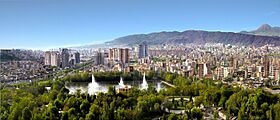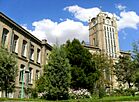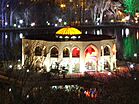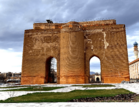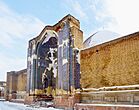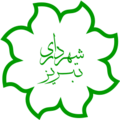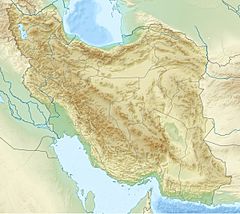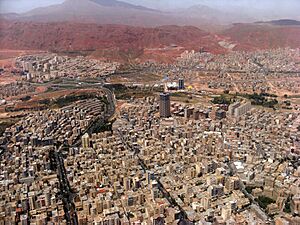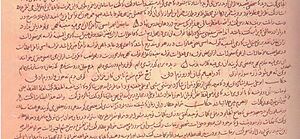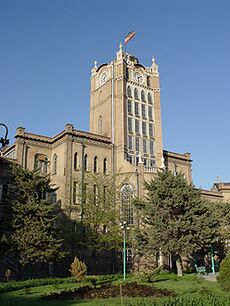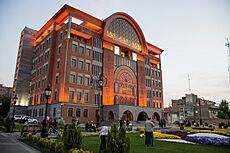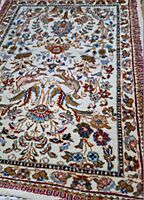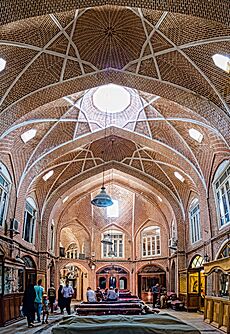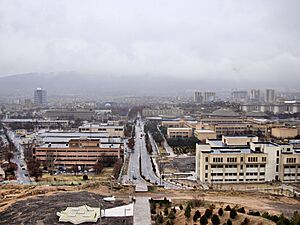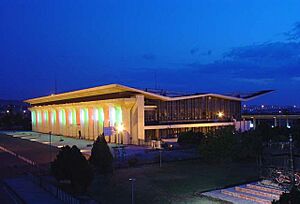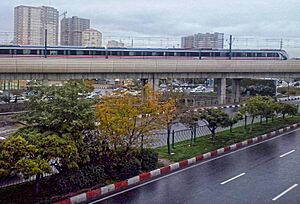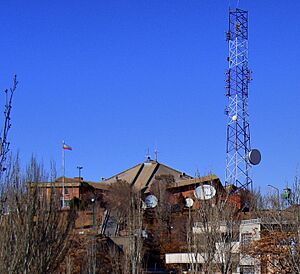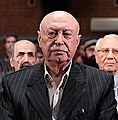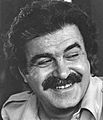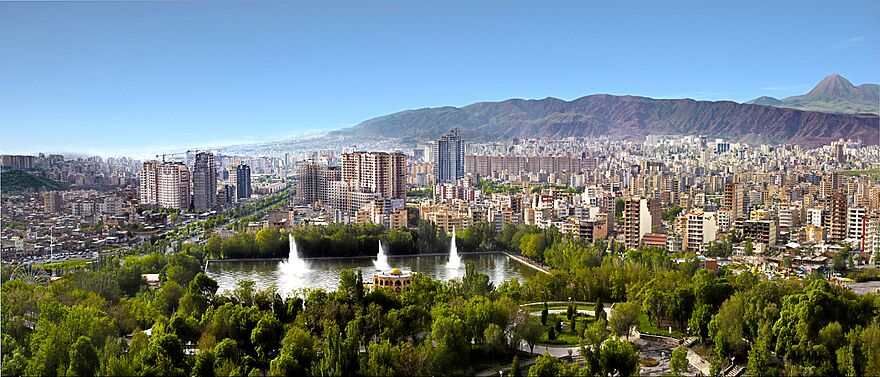Tabriz facts for kids
Quick facts for kids
Tabriz
Persian: تبریز
|
||
|---|---|---|
|
City
|
||
|
From top to bottom & from left to right: Skyline of the city, Tabriz Municipality Palace, El-Gölü, Arg of Tabriz, Blue Mosque, Bazaar of Tabriz, and Mausoleum of Poets.
|
||
|
||
| Nickname(s):
City of Firsts
|
||
| Country | Iran | |
| Region | 3 | |
| Province | East Azerbaijan | |
| County | Tabriz | |
| District | Central | |
| Area | ||
| • City | 325 km2 (125 sq mi) | |
| • Urban | 512 km2 (198 sq mi) | |
| • Metro | 1,500 km2 (600 sq mi) | |
| Elevation | 1,351.4 m (4,433.7 ft) | |
| Population
(2016)
|
||
| • Density | 12,000/km2 (30,000/sq mi) | |
| • Urban | 1,558,693 | |
| • Metro | 1,773,023 | |
| • Rank | 6th in Iran | |
| Demonyms | Tabrizian, Tabrizli, Tabrizi | |
| Time zone | UTC+3:30 (IRST) | |
| Postal code |
51368
|
|
| Area code(s) | 041 | |
Tabriz (Persian: تبریز; pronounced [tæbˈɾiːz]) is a large city in northwestern Iran. It is the capital of the East Azerbaijan province and the sixth-most-populated city in Iran.
Tabriz is located in the Quru River valley, between the Sahand and Eynali mountains. The city sits about 1,350 to 1,600 meters above sea level. This valley opens up to a plain that slopes down to Lake Urmia, about 60 kilometers to the west. In 2015, the World Crafts Council named Tabriz the World Carpet Weaving City. In 2018, the Organisation of Islamic Cooperation called it an Exemplary Tourist City.
With over 1.7 million people in 2016, Tabriz is the biggest economic center in northwest Iran. Most people speak Azerbaijani as their first language and Persian as their second. Tabriz is a major hub for heavy industries like cars, machine tools, oil refineries, and textiles. The city is also famous for its handmade items, especially hand-woven rugs and jewelry. Local sweets, chocolates, and traditional foods from Tabriz are known as some of the best in Iran. Tabriz is also a center for learning and culture in northwest Iran.
Tabriz has many old buildings that show how Iranian architecture has changed over time. Most of the historical sites in Tabriz that are still standing are from the Ilkhanid, Safavid, and Qajar periods. One of these is the huge Bazaar of Tabriz, which is a World Heritage Site. For a long time, Tabriz was very important for trade and travel between the Caucasus, Eastern Anatolia, and Central Iran. In more recent times, the city played a key role in Iran's history. Because it was close to Europe, many early modern changes in Iran started in Tabriz. Before Iran lost its Caucasian lands to Imperial Russia in the 1800s, Tabriz was a main center for Iranian rule in those areas. Until 1925, it was also the traditional home of the Qajar crown princes.
Contents
- What's in a Name?
- A Look Back at Tabriz's History
- People and Culture
- Geography and Climate
- How Tabriz is Governed
- Culture and Arts in Tabriz
- Places to See in Tabriz
- Parks and Green Spaces
- Tabriz Economy
- Education and Learning
- City Infrastructure
- Sports in Tabriz
- Media and News
- Famous People from Tabriz
- Sister Cities
- Consulates in Tabriz
- Panoramic View
- See also
What's in a Name?
Some people think the name Tabriz comes from tap-riz, meaning "flowing hot." This might refer to the many thermal springs in the area.
Other stories say that in 246 AD, an Armenian king named Tiridates II of Armenia renamed the city Tauris. This name came from an Armenian phrase meaning "this revenge." He did this after defeating an enemy king. However, this story comes from a historian who lived much later, in the 1200s, and older records don't mention it.
Some historians also connect Tabriz to an ancient fort called Tarui-Tarmakisa, which existed around 800 BC.
A Look Back at Tabriz's History
The early history of Tabriz is not fully known. The oldest signs of people living here are from an Iron Age graveyard, about 3,800 years ago. The city is also mentioned as Tarui or Tauris in ancient writings from 714 BC.
Some researchers even suggest that the legendary Garden of Eden might have been near Tabriz. However, this idea is not widely accepted by scholars.
Tabriz has been chosen as a capital city by many rulers throughout history. It has likely been destroyed and rebuilt many times by natural disasters or invading armies. The first parts of the current city might have been built in the 3rd or 4th century AD, or later in the 7th century.
From Ancient Times to Modern Era
After the Muslims took over Iran, the Arabian Azd tribe settled in Tabriz. The city began to grow more after this. In 791 AD, Zubaidah, the wife of a powerful ruler, rebuilt Tabriz after a big earthquake. She made the city so beautiful that she is sometimes called its founder.
In 1208, the Kingdom of Georgia took over Tabriz and nearby areas. This was in response to a massacre of Christians in another city.
After the Mongol invasion, Tabriz became the capital of the Ilkhanid Mongol empire in 1265. Under ruler Ghazan Khan in 1295, the city became very grand. New walls were built, and many public buildings and places for traders on the Silk Road were created. Many visitors from the west were amazed by the city's wealth and beauty. Marco Polo, who traveled the Silk Road around 1275, described Tabriz as "a great city surrounded by beautiful and pleasant gardens."
From 1375 to 1468, Tabriz was the capital of the Qara Qoyunlu state. Then, the Ag Qoyunlus made it their capital from 1469 to 1501. The Blue Mosque is one of the historical buildings from the Qara Qoyunlu time.
In 1501, Ismail I made Tabriz the capital of his new Safavid state. But in 1514, after a big battle, the city was attacked. In 1555, the Safavid ruler moved the capital to another city to avoid attacks from the Ottoman army.
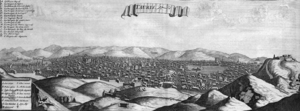
Tabriz was under the control of the Ottomans from 1585 to 1603. After the Safavids took it back, the city became a major trade center. It traded with the Ottoman Empire, Russia, and the Caucasus. Tabriz was hit by a very strong earthquake in 1641, which caused a lot of damage.
In 1721, another huge earthquake hit Tabriz, killing about 80,000 people. The city was also invaded by an Ottoman army in 1724–1725, leading to more deaths and suffering. In 1780, another major earthquake struck, killing as many as 200,000 people. Only about 30,000 people survived.
By the late 1700s, the city was divided. But in 1799, Abbas Mirza, a Qajar prince, became its governor. During the Qajar Empire, Tabriz was the home of the crown prince. The city was very important during the wars between Iran and Imperial Russia. In 1828, during the last of these wars, the city was captured by Russian soldiers. After a peace treaty was signed, the Russian army left. However, Russia still had a strong influence in Tabriz and northern Iran. After the Russians left, Abbas Mirza started to modernize Tabriz. He brought in Western ideas, new machines, and set up the first regular postal service. He also reformed the military and the tax system.
Tabriz in Modern Times
Because it was close to Europe, Tabriz became a center for the Iranian Constitutional Revolution from 1905 to 1911. This movement led to Iran getting a parliament and a constitution. Sattar Khan and Bagher Khan, two leaders from Tabriz, played a big role in this revolution. In 1909, Russian forces occupied Tabriz. They reinvaded in December 1911 and executed about 1,200 residents who supported the revolution. Russian forces occupied Tabriz until 1917.
-
Siege of Tabriz during Constitutional Revolution, September 27, 1908.
During World War I, Iran was neutral, but Tabriz was already occupied by Russia. Later, Ottoman troops took control, then Russia took it back. After the October Revolution in Russia, Russian armies left Iran. The Ottomans briefly captured Tabriz again before the war ended. After World War I, Reza Shah became king and started to modernize Iran. He wanted to unite the country and focused on centralizing power. This meant limiting local cultures and languages, including in Tabriz.
At the end of World War II, Iran was occupied by Allied forces. They helped Mohammad Reza become the new king. The Soviets also helped set up a local government in northwest Iran, with Tabriz as its capital. This government, led by Ja'far Pishevari, allowed more freedom for the Azerbaijani language and culture. It was popular, but after Soviet forces left, the Iranian army took back control. One important thing Pishevari's government did was open the University of Tabriz, which became very important for later political movements.
For the next 30 years, Tabriz was stable. It received a lot of money for its industries and became a major industrial center. Many people moved to Tabriz for work. While Tehran became the main center of the country, Tabriz became a gateway for new ideas and modernization.
In 1978, people in Tabriz played a big role in the Iranian Revolution. After the revolution, some residents were unhappy because the new government didn't fully respect the rights of the Azerbaijani minority. Many also supported a more liberal religious leader, Grand Ayatollah Shariatmadari, who disagreed with mixing religion and state. The unrest ended after protests were stopped and Shariatmadari was placed under house arrest.
In the 1980s, during the Iran–Iraq War, many building projects in Tabriz stopped to pay for the war. The city's industrial areas, especially the oil refinery, were often attacked by Iraqi air forces because they were close to the border and important to Iran's economy. Later, attacks also targeted residential areas.
In recent years, Tabriz has become much more stable. New buildings and developments are quickly changing the city's appearance.
Tabriz: A Capital City Through History
Tabriz has been a capital city for many rulers. It was the capital of the Ilkhanate (Mongol) dynasty starting in 1265. Under Ghazan Khan, who became ruler in 1295, the city reached its greatest glory. His empire stretched from the Amu Darya river in the East to the borders of Egypt in the West.
Tabriz was also the capital of Iran during the Qara Qoyunlu dynasty (1375–1468) and the Ag Qoyunlu dynasty (1468–1500). It was also the capital of the Safavid period from 1501 until 1555.
During the Qajar dynasty (1794–1925), Tabriz was where the Iranian Crown Prince lived.
Digging Up the Past
In 2002, during construction near the Blue Mosque, an ancient graveyard was found. It was kept secret for a while until a worker told the authorities. Tests showed that the graves were over 3,800 years old. A museum about these discoveries, including the Blue Mosque, opened in 2006.
Another excavation site is on Abbasi Street, at the location of Rab'-e Rashidi. This was once an important academic center about 700 years ago, built during the Ilkhanid period.
People and Culture
Languages Spoken
The main language in Tabriz is Azerbaijani, which is a Turkic language. It is similar to modern Turkish. Most people also speak Persian, which is the official language and used in schools. The Iranian constitution allows for some education in other native languages, like Azerbaijani. In 1999, the University of Tabriz started an academic program for the Azerbaijani language. Besides Azerbaijani, there are smaller groups of people who speak Armenian and Assyrian Neo-Aramaic.
It is believed that before Azerbaijani became common, other Iranian languages similar to Persian were spoken in Tabriz. A 13th-century book called Safina-yi Tabriz has poems in what its author called the "Tabrizi language," which was similar to Persian.
Religions in Tabriz
In 1501, after becoming king in Tabriz, Shah Ismail I declared Twelver Shia Islam as the official religion of the Safavid Empire. Because of this, most people in Tabriz, who were then Sunni Muslims, were encouraged to become Shia. Today, most people in Tabriz follow Shia Islam.
The city also has a noticeable Armenian Apostolic Christian community. There used to be a small Jewish community, but most have moved to Tehran. There is also a small community of the Baháʼí Faith in the city.
Population Growth
| Historical population | ||
|---|---|---|
| Year | Pop. | ±% |
| 1956 | 289,996 | — |
| 1966 | 403,413 | +39.1% |
| 1976 | 1,074,173 | +166.3% |
| 1991 | 1,088,985 | +1.4% |
| 1996 | 1,191,043 | +9.4% |
| 2006 | 1,398,060 | +17.4% |
| 2011 | 1,494,998 | +6.9% |
| 2016 | 1,558,693 | +4.3% |
| source: | ||
Iran started counting its population in 1956. The 1976 count showed that Tabriz's population had more than doubled in ten years. This was because many people moved from rural areas to the city. In 2016, the city's population was 1,558,693 people. Most of the people in Tabriz are Azerbaijani. There are also groups of Persians, Kurds, Armenians, and Assyrians.
Geography and Climate
City Location and Features
Tabriz is in the northwest of Iran, in the East Azerbaijan province. It is located between the Eynali and Sahand mountains. The city is in a fertile area near the Aji River and Quri River.
The area around Tabriz often experiences earthquakes. Because of this, the city has been destroyed and rebuilt many times throughout its history.
Weather in Tabriz
Tabriz has a cold, semi-dry climate. This means it has hot summers and snowy, cold winters. The city gets about 260 millimeters of rain each year. Most of this rain falls as snow in winter and as rain in spring and autumn. Spring and autumn in Tabriz are usually mild and pleasant. The average temperature for the whole year is about 13.1 degrees Celsius. Cool winds often blow from east to west, especially in summer.
A French traveler named Jean Chardin visited Tabriz in the 1600s. He wrote that it was cold for most of the year. He also noted that snow stays on the mountain peaks for nine months. Winds blow in the mornings and nights, and it rains in all seasons except summer. The weather is often cloudy throughout the year.
- Highest temperature ever recorded: 42.0°C on July 26, 1966
- Lowest temperature ever recorded: -25.0°C on January 20, 1964
| Climate data for Tabriz (1991–2020 normals, extremes 1951–present) | |||||||||||||
|---|---|---|---|---|---|---|---|---|---|---|---|---|---|
| Month | Jan | Feb | Mar | Apr | May | Jun | Jul | Aug | Sep | Oct | Nov | Dec | Year |
| Record high °C (°F) | 16.0 (60.8) |
19.0 (66.2) |
25.6 (78.1) |
31.2 (88.2) |
33.8 (92.8) |
39.0 (102.2) |
42.0 (107.6) |
41.0 (105.8) |
38.0 (100.4) |
30.6 (87.1) |
23.4 (74.1) |
21.8 (71.2) |
42.0 (107.6) |
| Mean daily maximum °C (°F) | 3.6 (38.5) |
6.5 (43.7) |
12.1 (53.8) |
17.9 (64.2) |
23.7 (74.7) |
30.0 (86.0) |
33.6 (92.5) |
33.7 (92.7) |
28.9 (84.0) |
21.5 (70.7) |
12.3 (54.1) |
5.7 (42.3) |
19.1 (66.4) |
| Daily mean °C (°F) | −1.2 (29.8) |
1.3 (34.3) |
6.5 (43.7) |
12.1 (53.8) |
17.4 (63.3) |
23.3 (73.9) |
26.6 (79.9) |
26.6 (79.9) |
21.8 (71.2) |
14.8 (58.6) |
6.7 (44.1) |
1.0 (33.8) |
13.1 (55.5) |
| Mean daily minimum °C (°F) | −5.3 (22.5) |
−3.4 (25.9) |
1.1 (34.0) |
6.2 (43.2) |
11.0 (51.8) |
16.3 (61.3) |
20.1 (68.2) |
20.0 (68.0) |
15.0 (59.0) |
8.7 (47.7) |
2.0 (35.6) |
−3 (27) |
7.4 (45.3) |
| Record low °C (°F) | −25.0 (−13.0) |
−22.0 (−7.6) |
−19.0 (−2.2) |
−12.0 (10.4) |
−0.1 (31.8) |
4.0 (39.2) |
7.0 (44.6) |
10.0 (50.0) |
4.0 (39.2) |
−4.0 (24.8) |
−17.0 (1.4) |
−19.5 (−3.1) |
−25.0 (−13.0) |
| Average precipitation mm (inches) | 20.3 (0.80) |
20.4 (0.80) |
31.6 (1.24) |
51.5 (2.03) |
38.3 (1.51) |
10.9 (0.43) |
6.7 (0.26) |
3.6 (0.14) |
5.6 (0.22) |
19.3 (0.76) |
27.0 (1.06) |
23.3 (0.92) |
258.5 (10.17) |
| Average precipitation days (≥ 1.0 mm) | 4.4 | 4.2 | 6.6 | 7.4 | 7.1 | 2.2 | 1.3 | 0.7 | 1.4 | 3.2 | 4.5 | 4.6 | 47.6 |
| Average snowy days | 9.3 | 7.9 | 4.9 | 1.0 | 0.0 | 0.0 | 0.00 | 0.0 | 0.0 | 0.3 | 1.8 | 6.2 | 31.4 |
| Average relative humidity (%) | 71 | 65 | 56 | 53 | 48 | 37 | 34 | 33 | 37 | 47 | 62 | 70 | 51.1 |
| Average dew point °C (°F) | −6.0 (21.2) |
−5.0 (23.0) |
−2.7 (27.1) |
1.7 (35.1) |
5.0 (41.0) |
6.3 (43.3) |
8.3 (46.9) |
7.6 (45.7) |
5.2 (41.4) |
2.6 (36.7) |
−0.6 (30.9) |
−4.2 (24.4) |
1.5 (34.7) |
| Mean monthly sunshine hours | 141 | 161 | 192 | 213 | 273 | 332 | 350 | 343 | 302 | 241 | 179 | 136 | 2,863 |
| Source 1: NOAA NCEI, | |||||||||||||
| Source 2: IRIMO(records), (snow/sleet days 1951–2010) | |||||||||||||
Environmental Concerns
Air pollution is a big environmental issue in Tabriz. This is caused by many cars and polluting industries, like power plants and oil refineries. While industrial pollution has decreased recently, the air quality is still not as good as global standards.
Another major concern is the shrinking of Lake Urmia, which is near Tabriz. The lake has been drying up since the late 1900s. Its water level is dropping, and it's becoming very salty. This is due to global warming and more demand for water. People worry that salty dust from the lakebed could cause health problems in the future.
How Tabriz is Governed
The city is run by a Mayor, who is chosen by a city council. The city council members are elected by the people of Tabriz. The main office for the city government is in the Tabriz Municipality Palace.
City Districts
Tabriz is divided into 10 main city districts. Each district has many older neighborhoods that are important for their culture and history.
The city also has many modern districts, including:
- Parvaz
- Golshahr
- Zafaranieh
- Rajae Shahr
- Hafez
- Mandana
- Nesfrah
- Valieamr
- Narmak
- Yaghchian
- Marzdaran
- Baghmishe
- Elahiyeh
- Abrisham
- Baharestan
- Misagh
- Sahand
- Ashkan
- Jamaran
- Abresan
- Vali Asr
- Elahi Parast
- Ferdows
- North Fereshteh
- Roshdieh
- Mirdamad
- Andishe
- Khavaran
Culture and Arts in Tabriz
Literature and Poetry
Sahand, o mountain of pure snow,
Descended from Heaven with Zoroaster
Fire in your heart, snow on your shoulders,
with storm of centuries,
And white hair of history on your chest ...
Yadollah Maftun Amini (born in 1926)
Tabriz has always been a center for trade, culture, and art. Its location on the Silk Road helped it become a place where different cultures met. In modern times, the opening of schools and the University of Tabriz helped cultural development even more.
Tabriz is also where the famous "Tabriz School" of painting started. This art style was popular during the Ilkhanate and Safavid periods, greatly influencing Iranian art.
The nearby Sahand mountain has inspired many poets and revolutionaries. Tabriz has been home to many famous Iranian writers and poets, from old masters like Rumi and Khaqani to more recent ones like Samad Behrangi and Parvin E'tesami. The well-known Iranian Azerbaijani poet Mohammad-Hossein Shahriar was born in Tabriz. The city's culture, values, language, and music are a mix of what is found across Iran.
Tabriz is also special in Persian literature, as shown by these lines from famous Iranian poets:
|
ساربانا بار بگشا ز اشتران Oh Sārbān, have the camels' cargo unloaded, عزیزی در اقصای تبریز بود A beloved lived in Tabriz away from sight, |
تا به تبریزم دو چیزم حاصل است As long as I live in Tabriz, two things I need not worry about, اين ارك بلند شهر تبريز است This is the tall Arg of Tabriz City, |
Music Traditions
For a long time, central governments in Iran tried to make everyone follow one main culture. This caused Tabriz to lose some of its unique cultural identity. However, with more open policies in the late 1990s, local music started to become popular again.
Traditional Azerbaijani music has two main types: "ashugh" and "mugham". Mugham is similar to Persian classical music and is becoming more popular among young, educated people. For example, Nasir Atapur from Tabriz won a Mugham contest in 2007.
Ashugh music comes from the mountainous region of Qaradağ. It is now seen as a key part of Azerbaijani culture. Ashughs were traveling singers who played a string instrument called a saz. Their music often talks about mountains and nature, creating a feeling of gentle sadness. The first lines of a song by Məhəmməd Araz show this:
Bəlkə bu yerlərə birdə gəlmədim (I may not come to these mountains again)
duman səlamət qal dağ səlamət qal (Farewell to the Mist and to the mountain)
arxamca su səpir göydə bulutlar (Clouds sprinkle drops of rain)
leysan səlamət qal yağ səlamət qal (Farewell to summer days, farewell to the rain)
Painting Styles
The "Tabrizian style" of painting developed during the Ilkhanid, Kara Koyunlu, and Safavid periods. These paintings, from the early 1300s, show a strong influence from Chinese art. Over time, Tabriz became a major center for Persian miniature painting. The novel My Name Is Red by Orhan Pamuk tells a fictional story about this painting style during the Safavid era.
Delicious Tabrizi Food
Tabriz is known for its tasty dishes and sweets. Some famous foods include:
- Aash: A type of soup made with broth, vegetables, noodles, and spices.
- Abgoosht or Shorva: A hearty soup made from lamb and chickpeas. It was a main dish for many families in Tabriz for a long time.
- Chelow kabab: Grilled meat (kebab) and roasted tomatoes served with steamed rice. This is a national dish of Iran, and Tabriz is famous for its high-quality chelow kabab.
- Dolma: A traditional food where vegetables like eggplant, capsicum, tomato, or zucchini are filled with a mix of meat, split peas, onion, and spices.
- Garniyarikh: An Azerbaijani dish meaning "the torn abdomen." It is a type of dolma filled with meat, garlic, almonds, and spices.
- Tabriz meatballs: Large meatballs made from ground meat, rice, and leeks, plus other ingredients. The word kofta comes from a Persian word meaning "to beat" or "to grind."
-
A table of some of Tabriz traditional foods (köfte and syrup with sangak and Bonab Kababi with rice)
-
Qurutli Aash, a thick soup made of qurut
Tabriz also has special sweets, biscuits, and cookies. These include Qurabiya, Tabrizi Lovuez, Riss, Nougat, Tasbihi, Latifeh, Ahari, Lovadieh, and Lokum.
Places to See in Tabriz
Tabriz has been damaged by many earthquakes over time, so only a few historical buildings remain. Some have also been partly destroyed by new construction. However, there are still many interesting places to visit, such as:
- Aji Chay Bridge
- Amir Nezam House (Qajar museum)
- Arg of Tabriz
- Azerbaijan Museum
- Bazaar of Tabriz, a world heritage site
- Behnam House (school of architecture)
- Blue Mosque (Goy Masjid)
- Constitutional Revolution House of Tabriz (Mashrouteh museum)
- Iron Age museum
- Jamee mosque of Tabriz
- Maqbaratoshoara (tomb of poets)
- Measure museum
- Municipality of Tabriz
- Nobar bath
- Qari Bridge
- Roshdieh school
- Rug museum
- Ruins of Rabe Rashidi University
- Saheb ol Amr mosque
- Saint Mary Church of Tabriz (Armenian church)
- Shahryar literature museum (house of Shahryar)
- Tabriz Fire Fighting Tower
- Tabriz Railway Station
-
Amir Nezam House (Qajar museum)
Parks and Green Spaces
Tabriz has 132 parks, including small local parks and larger city parks. In 2005, the city had 2,595 square kilometers of parks and 8,548 square kilometers of green spaces. This means there was about 5.6 square meters of green space per person. However, a study in 2018 found that most green spaces are on the edges of the city or in wealthy areas. Some districts have very little green space per person. The oldest park in Tabriz, Golestan Baği, was built in the city center during the first Pahlavi era. Tabriz also has 8 parks for travelers, which can hold up to 10,000 visitors.
Some popular parks include:
- Baghlar Baghi
- Khaqani Park
- Golestan Park
- Shah Goli Park
- Eynali state forest park.
Tabriz Economy
Tabriz is the biggest economic center in Northwest Iran. Its economy relies on trade, services, healthcare, and various industries, both small and large, as well as handicrafts. Five of Iran's top 100 companies are based in Tabriz, including ITMCO and Shirin Asal.
Industries in Tabriz
Modern industries in Tabriz began in the early 1900s with match factories. Today, the city produces machinery, vehicles, chemicals, petrochemicals, refined oil products, cement, electrical goods, home appliances, textiles, and medicines.
There are many industrial areas in Tabriz. One of the largest is the Iran Tractor Manufacturing Co (ITMCO). This company has the biggest foundry and forging capacity in the Middle East and is the largest tractor maker in Iran. Other big industrial complexes include Mashin Sazi Tabriz Co, Iran Diesel Engine Manufacturing Co (IDEM), and Tabriz Petrochemical Complex.
Tabriz is also known for its food industry, especially chocolate factories. The city is sometimes called the Chocolate City of Iran. Companies like Aidin and Soniz are among the biggest in the region.
Many people in Tabriz work in small businesses, such as shoemaking, stone-cutting, furniture making, and confectionery.
Famous Handicrafts
Tabriz is known worldwide for its unique handicrafts and carpets. The city is a main center for making famous Iranian Rugs. Tabriz carpets are known for being very strong and having special designs. They often have light backgrounds with blue, rose, and indigo patterns. Many feature a single medallion in the middle, surrounded by vines. The weaving style of Tabriz rugs makes them very durable. While their designs are not always as distinct as those from other cities, their high quality and strength are well-known.
Besides carpets, Tabriz is famous for other crafts like silverware, wood engraving, pottery and ceramics, and different types of Mosaic and embroidery.
-
A newly made bronze astrolabe, as a sample of Ghalamzani in Tabriz
Shopping in Tabriz
Most shopping centers are in the city center. These include the Grand Bazaar of Tabriz and pedestrian streets like Tarbiyat street and Shahnaz street. There are also modern malls and fancy shops selling jewelry, rugs, clothes, and sweets in areas like Abresan and Kouy Valiasr.
Many malls in Tabriz specialize in certain products, such as home appliances, shoes, or books.
Tabriz also hosts seasonal shopping fairs, mainly at the Tabriz International Exhibition Center.
Tabriz International Exhibition Center
The Tabriz International Exhibition Center, located in the eastern part of the city, hosts many exhibitions each year. The most famous one is TEXPO, a general trade fair usually held in early August.
Education and Learning
Universities and Higher Education
Tabriz is home to 14 important universities and higher education institutes in Iran. The University of Tabriz, founded in 1947, is the most respected university in northwest Iran. It is also one of the five main universities in the country, serving as a regional science hub.
Other public universities in and around Tabriz include:
- Tabriz University of Medical Sciences: Has departments for various medical fields. It used to be part of the University of Tabriz.
- Islamic Azad University, Tabriz Branch: Established in 1982, with faculties in different subjects like Law.
- Sahand University of Technology: Founded in 1989, specializing in engineering and technology.
- Azarbaijan University of Tarbiat Moallem: A general university established in 1987, with its main campus in Azarshahr county.
- Tabriz Islamic Arts University: A public university founded in 1997.
- The Payam-e Noor University of Tabriz: Part of a network for distance learning.
There are also private universities and technical colleges in the city.
Famous High Schools
Hundreds of schools in Tabriz follow the Iranian education system. Students attend primary school for five years, middle school for three years, and secondary school for three years. While Azerbaijani is the main language spoken in Tabriz, Persian is used in classrooms. Some high schools are famous for their history or high quality of education.
Here are some of the most famous high schools:
- Memorial School (American School of Tabriz): Opened in 1891, it was one of the most famous American Missionary Schools in Iran. After World War II, it became Parvin High School.
- Roshdieh School: The first modern Iranian school, founded by Haji-Mirza Hassan Roshdieh. Its building is now used as a library office.
- Vahdat Technical College: Developed by Germans before World War II.
- Ferdowsi High School: One of the largest high schools, originally built by German engineers as a hospital.
- Mansur High School: Founded in 1945, it was a top-ranking school.
- Shahid Madani and Farzanegan High Schools: These schools admit students through a tough entrance exam and are known for their high success rates in university entrance exams.
Libraries for Learning
Tabriz National Library, also known as the Central Library of Tabriz, is the largest and most famous library in the city. It has a huge collection of old handwritten Persian literature in northwest Iran. There are also many other public libraries throughout the city.
City Infrastructure
Getting Around Tabriz
People in Tabriz use public buses, taxis, the metro, bikes, and personal cars to get around. The city has a network of bus lines connecting different areas to the city center. There's also a Bus Rapid Transit (BRT) line that runs for 18 kilometers.
Part of Tabriz's subway line 1 started operating in 2015. Several other lines are planned to connect different parts of the city, but construction has been slower than expected.
Tabriz is connected to Europe through Turkey's roads and the Bazargan border. It is also linked to Tehran by Freeway 2 (Iran).
The city is connected to Iran's national railway system and to Europe through Turkey's railways. Tabriz was the first city in Iran to have a railway, with the Tabriz-Jolfa line built in 1912–1914. The Tabriz Railway Station is in the western part of the city.
Tabriz International Airport opened in 1950 and is the only international airport in East Azerbaijan. It has daily and weekly flights to cities within Iran and to international destinations like Istanbul, Tbilisi, Baghdad, and Baku.
Sports in Tabriz
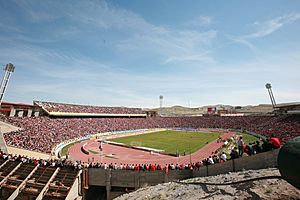
Tabriz is a major center for sports events in the region. The city has several sports complexes. The main one inside the city is Bagh Shomal, which includes a soccer stadium, swimming pool, and courts for basketball and volleyball. There's also a larger Olympic village with a soccer stadium and a cycling track. Soccer and cycling are very popular due to the city's teams and international events.
Football Excitement
Football is a huge part of Tabriz's culture. Tractor SC is one of the most popular football clubs in Iran and Asia. Tractor plays in the Iran Pro League. Their home stadium is Sahand Stadium, which can hold 80,000 people.
In June 1976, the Bagh Shomal Stadium in Tabriz hosted some of the final games of the 1976 AFC Asian Cup.
Futsal Success
The city's main futsal (indoor soccer) club is Mes Sungun. Founded in 2010, they play at the Shahid Poursharifi Arena. The club has won many Iranian Futsal Super League titles and the AFC Futsal Championship in 2018.
Cycling Events
Tabriz hosts the Azerbaijan Cycling Tour every year since 1986. This is the most important cycling tour in Iran. Tabriz is also home to the Tabriz Petrochemical Cycling Team, which competes in international cycling events.
Skiing Fun
Sahand and Yam ski resorts are about an hour's drive from Tabriz. They usually open from late December to early March, depending on the snow.
Media and News
Tabriz has a state television channel called Sahand TV. It broadcasts programs in both Persian and Azerbaijani languages. You can watch it internationally through satellites.
The city also has a government-controlled radio channel that broadcasts in both Persian and Azerbaijani.
Tabriz has several weekly magazines and main newspapers, including Amin, Mahd Azadi, Asr Azadi, and Fajr Azarbaijan.
Famous People from Tabriz
Throughout its long history, Tabriz has been a birthplace for many important figures in Iran. These include politicians, revolutionaries, artists, and military leaders. Here is a partial list of some notable people who were born or lived in Tabriz:
For a complete list see: Category:People from Tabriz and List of people from Tabriz
-
Iraj Mirza, poet
-
Farah Pahlavi, was the Shahbanu (empress) of Iran
-
Samad Behrangi, teacher and writer
-
Tahmineh Milani, film director
-
Parvin Etesami, 20th-century Persian poet
-
Dariush Shayegan, philosopher
-
Karim Bagheri, professional football player and coach
Sister Cities
Tabriz has special friendly relationships with these cities, called "sister cities":
Consulates in Tabriz
Azerbaijan and Turkey have consulate offices in Tabriz. In the past, the Soviet Union and the United States also had consulates here.
Panoramic View
See also
 In Spanish: Tabriz para niños
In Spanish: Tabriz para niños


